Apparel Care Labels: Rules, Symbols, FTC And Tips
Hey there, fellow apparel entrepreneurs! When you’re pouring your heart and soul into designing, sourcing, and selling fantastic clothes, it’s easy to get caught up in the big picture – the designs, the marketing, the sales. But as anyone who’s been in the garment game for a while knows, success often hinges on the details. One of the smallest, yet most crucial, details on any piece of clothing? That little tag tucked inside: the care label.
You might think of it as just a small instruction manual, but honestly, it’s so much more. What is a care label, really? At its core, it’s your direct communication with your customer long after they’ve made the purchase, guiding them on how to keep their new favorite garment looking great wash after wash.
Getting this right isn’t just about good customer service; it’s fundamental to product longevity, brand reputation, and, importantly, legal compliance, especially here in the U.S. market. Let’s dive into what every clothing business owner needs to understand about these essential tags.
1. Defining the Care Label: More Than Just a Clothing Tag
A care label is a tag or label permanently attached to a textile product providing instructions for its regular care. This isn’t just any clothing tag; its key attributes are permanence and legibility. The label must remain securely fastened and readable throughout the expected useful life of the garment. Essential care instructions, such as washing instructions and drying instructions, are conveyed through text or standardized symbols.
Common physical formats include sewn-in labels, often made from materials like woven fabric or satin polyester, and printed labels, frequently using materials. While the materials differ, both serve the vital purpose of conveying care information clearly. A permanent label ensures the user always has access to the necessary care guidance.
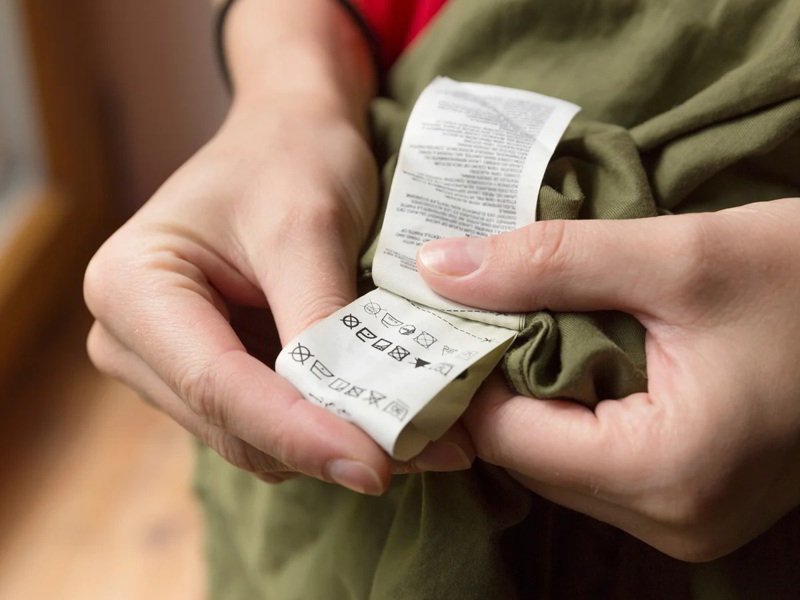
2. Why Accurate Care Labels are Crucial for Your Apparel Business
Accurate care labels are far more than a minor detail; they are fundamental to your apparel business’s success and reputation. Here’s why:
- Garment Longevity: Following correct care instructions significantly extends the life of clothing, maintaining its quality, fit, and appearance. Incorrect laundering can quickly lead to damage like shrinking, fading, or fabric distortion.
- Customer Trust and Satisfaction: Providing clear, accurate care guidance builds customer trust. When customers can easily care for their purchases, satisfaction increases, leading to repeat business and positive reviews. Conversely, damaged garments due to poor instructions often result in complaints and costly returns.
- Legal Compliance (USA): In the USA, the Federal Trade Commission (FTC) enforces the FTC Care Labeling Rule. This regulation mandates clear and accurate care instructions on most textile apparel. Non-compliance can lead to fines and damage your brand’s reputation. Adhering to these regulations is not optional.
- Influencing Consumer Behavior: Ease-of-care is a significant factor for many consumers. A garment labeled “Dry Clean Only” might deter a consumer seeking low-maintenance clothing, while clear, simple washing instructions can be a selling point.
- Brand Image: Professional, accurate care labels reflect a commitment to quality and customer care. They signal that you stand behind your product and want consumers to enjoy it for as long as possible.
2.1 Washing Symbols (The Wash Tub)
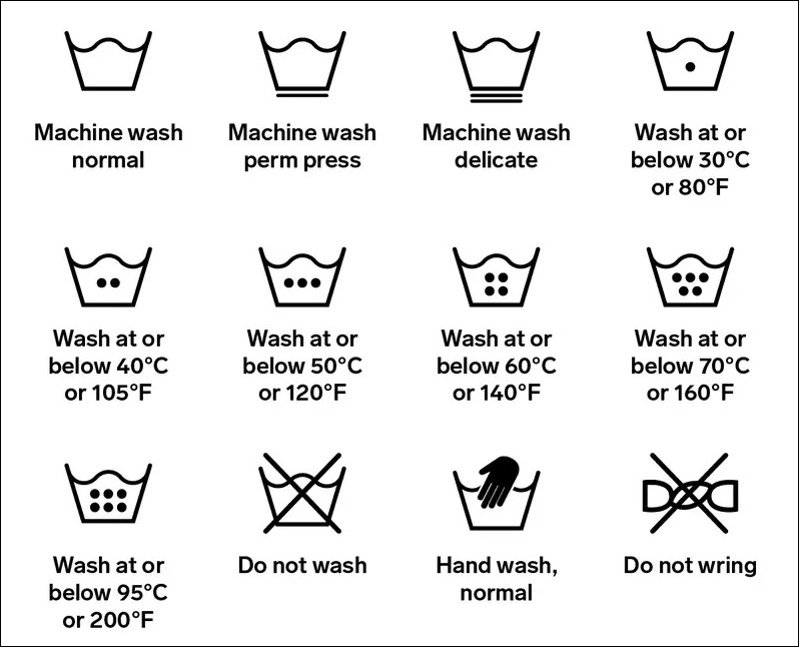
The wash tub symbol provides instructions for washing garments. Understanding these variations is key to proper garment care according to ASTM (American Society for Testing and Materials) standards used in the US.
- Basic Machine Wash: An empty tub symbol indicates the item can be machine washed, generally assuming hot water is safe unless otherwise specified.
- Water Temperature: The dots indicate the maximum water temperature: one dot for cold (approx. 30°C / 85°F), two for warm (approx. 40°C / 105°F), and three for hot (approx. 50°C / 120°F). If no dots are shown, hot water is generally acceptable.
- Machine Cycle: Bars underneath the tub indicate the required cycle: one bar for the Permanent Press cycle (medium agitation), two bars for the Gentle/Delicate cycle (slow agitation), and no bars for a Normal cycle (maximum agitation and spin).
- Hand Wash: A symbol showing a hand in the tub means the garment should only be washed by hand, typically gently in cool or warm water.
- Do Not Wash: A wash tub with an ‘X’ through it means the item should not be washed in water. It likely requires dry cleaning or cannot be cleaned.
Table: Washing Symbols
| Symbol | Meaning | Explanation |
|---|---|---|
| Basic Wash Tub | Machine Wash | Safe to wash in a machine (assume normal cycle, hot water unless specified) |
| Wash Tub 1 Dot | Machine Wash Cold | Maximum water temperature 30°C / 85°F |
| Wash Tub 2 Dots | Machine Wash Warm | Maximum water temperature 40°C / 105°F |
| Wash Tub 3 Dots | Machine Wash Hot | Maximum water temperature 50°C / 120°F |
| Wash Tub 1 Bar | Permanent Press | Use permanent press cycle (reduced agitation/spin) |
| Wash Tub 2 Bars | Gentle/Delicate | Use gentle cycle (slow agitation/spin) |
| Hand Wash | Hand Wash | Wash by hand only; do not machine wash. |
| Do Not Wash | Do Not Wash | Do not wash in water. |
2.2 Bleaching Symbols (The Triangle)

The triangle symbol relates to the use of bleach. Incorrect bleaching can cause irreversible damage, making these symbols crucial. These follow ASTM guidelines.
- Any Bleach: An empty triangle means any commercially available bleach (chlorine or non-chlorine) can be used when needed.
- Only Non-Chlorine Bleach: A triangle with two diagonal lines inside indicates that only Non-Chlorine Bleach (also known as oxygen bleach or color-safe bleach) should be used. Chlorine bleach will likely damage the fabric or color.
- Do Not Bleach: A solid black triangle with an ‘X’ through it means Do Not Bleach. No type of bleach product should be used on the garment.
Table: Bleaching Symbols
| Symbol | Meaning |
|---|---|
| Any Bleach Triangle | Any Bleach When Needed |
| Non-Chlorine Bleach | Only Non-Chlorine Bleach |
| Do Not Bleach | Do Not Bleach |
2.3 Drying Symbols (The Square)
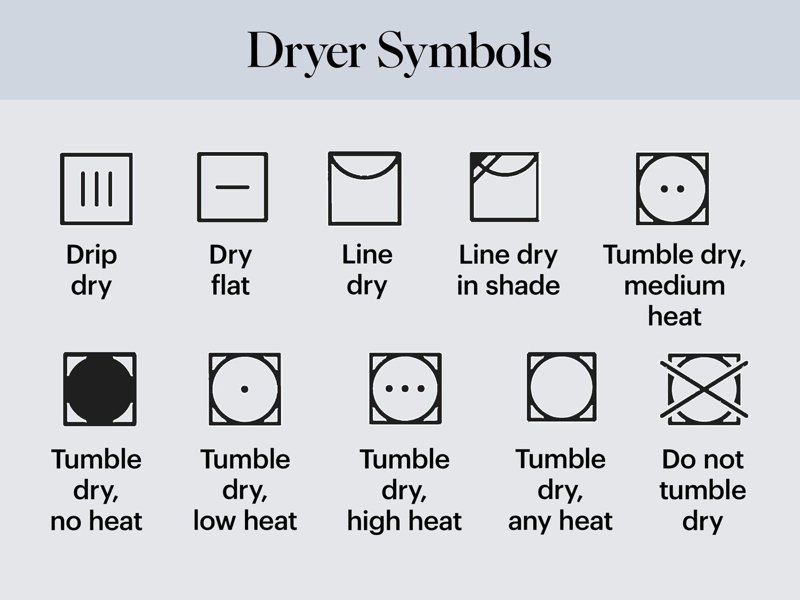
The square symbol addresses drying methods, encompassing both machine (tumble) drying and natural drying techniques as per ASTM standards.
Tumble Dry (Circle within the Square)
- Basic Tumble Dry: A square with a circle inside permits machine drying. If no dots, high heat is usually acceptable.
- Heat Settings: Dots inside the circle specify the dryer’s heat level: one dot for low heat, two for medium, and three for high. A filled black circle indicates no heat is required, often for an air fluff cycle.
- Cycle: Bars underneath the square indicate the recommended dryer cycle. One bar signifies the Permanent Press cycle, which uses medium heat and a cool-down period, while two bars denote the Gentle/Delicate cycle with low heat and gentle tumbling.
- Do Not Tumble Dry: A tumble dry symbol with an ‘X’ through it prohibits machine drying.
Natural Drying (Square without Inner Circle)
- Line Dry / Hang to Dry: A square with a curved line at the top (like an envelope) means hang the damp garment on a line or hanger.
- Dry Flat: A square with a horizontal line in the middle means lay the garment flat on a surface to dry, often used for sweaters to prevent stretching.
- Drip Dry: A square with three vertical lines inside means hang the garment dripping wet (usually without spinning or wringing) on a line or hanger, often over a tub or outdoors.
- Dry in Shade: A square with two diagonal lines in the top left corner (sometimes combined with Line Dry or Dry Flat symbols) means dry away from direct sunlight to prevent fading.
Other Drying Symbols
- Do Not Wring: A symbol resembling a twisted cloth with an ‘X’ through it warns against wringing out excess water, often used for delicate fabrics prone to distortion.
Table: Drying Symbols
| Symbol | Meaning | Method |
|---|---|---|
| Tumble Dry Basic | Tumble Dry, Normal | Machine Dry |
| Tumble Dry Low | Tumble Dry, Low Heat | Machine Dry |
| Tumble Dry Medium | Tumble Dry, Medium Heat | Machine Dry |
| Tumble Dry High | Tumble Dry, High Heat | Machine Dry |
| Tumble Dry Perm Press | Tumble Dry, Permanent Press | Machine Dry |
| Tumble Dry Gentle | Tumble Dry, Gentle | Machine Dry |
| Do Not Tumble Dry | Do Not Tumble Dry | — |
| Line Dry | Line Dry / Hang Dry | Natural Dry |
| Dry Flat | Dry Flat | Natural Dry |
| Drip Dry | Drip Dry | Natural Dry |
| Do Not Wring | Do Not Wring | Handling |
2.4 Ironing Symbols (The Iron)
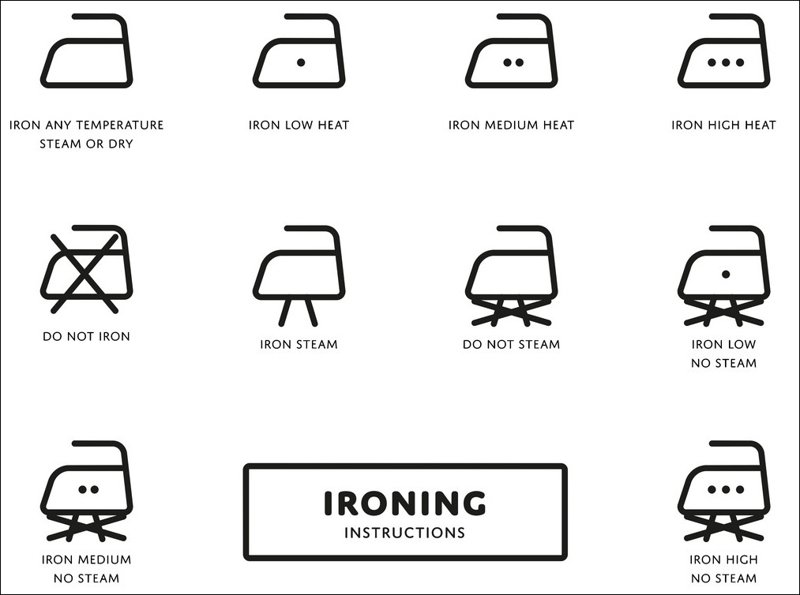
The iron symbol provides guidance on whether and how to iron a garment, following ASTM recommendations.
- Basic Iron: An iron symbol indicates the garment can be ironed. If no dots are present, the highest heat setting (Hot) is generally safe.
- Temperature Settings: Dots inside the iron indicate the heat setting. One dot signifies a cool iron (approx. 110°C / 230°F) for synthetics, two dots indicate a warm iron (approx. 150°C / 300°F) for wool and silk, and three dots represent a hot iron (approx. 200°C / 390°F) for cotton and linen.
- Do Not Iron: An iron symbol with an ‘X’ through it means the garment should not be ironed.
- No Steam: An iron symbol with crossing lines through the steam emitting from the bottom means iron without steam. Steam could damage the fabric.
Table: Ironing Symbols
| Symbol | Meaning | Temperature Setting |
|---|---|---|
| Basic Iron | Iron, Any Temp | High (if no dots shown) |
| Cool Iron | Cool Iron | Low (approx. 110°C/230°F) |
| Warm Iron | Warm Iron | Medium (approx. 150°C/300°F) |
| Hot Iron | Hot Iron | High (approx. 200°C/390°F) |
| Do Not Iron | Do Not Iron | — |
| No Steam Iron | Iron, No Steam | As indicated by dots |
2.5 Professional Cleaning Symbols (The Circle)
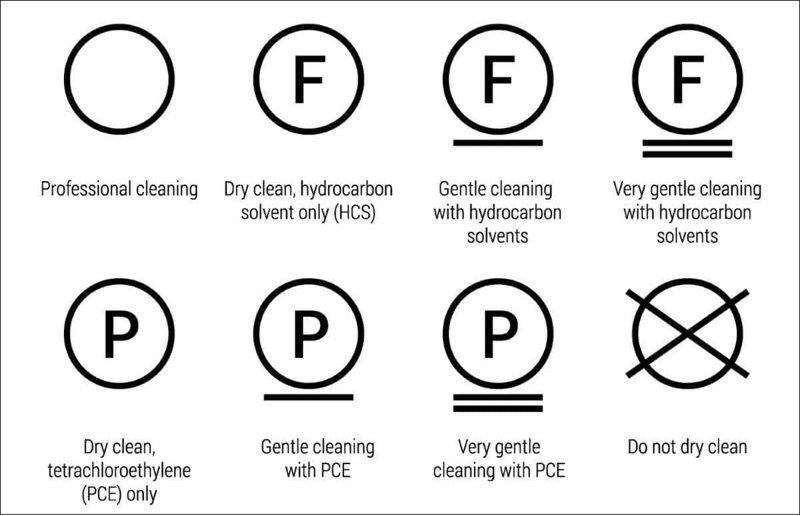
A circle indicates that professional cleaning (either Dry Cleaning or Professional Wet Cleaning) is required or recommended based on ASTM symbols. These symbols guide the professional cleaner.
- Professional Cleaning Required: A basic circle generally means the item should be professionally cleaned. Specific instructions usually follow.
- Do Not Dry Clean: A circle with an ‘X’ through it means the garment cannot be safely dry cleaned using traditional dry cleaning methods.
- Dry Cleaning Solvent Type (Letters inside Circle): The letter inside the circle indicates the safe type of solvent to use. A means any solvent is acceptable. P requires Perchloroethylene (PCE) based solvents only. F specifies the use of petroleum-based solvents only, which is often a gentler process.
- Modified Dry Cleaning Process (Bars under Circle): Bars under the circle signal the need for a gentler process. One bar indicates a mild process (less moisture, heat, or agitation), while two bars require a very gentle process.
- Professional Wet Cleaning: A ‘W’ inside the circle indicates Professional Wet Cleaning is suitable. This is a water-based process performed by professionals with specialized equipment, distinct from home washing or traditional dryclean methods. Bars underneath indicate gentle (one bar) or very gentle (two bars) wet cleaning.
- Do Not Wet Clean: A ‘W’ in a circle with an ‘X’ through it prohibits professional wet cleaning.
Table: Professional Cleaning Symbols
| Symbol | Meaning | Notes |
|---|---|---|
| Dry Clean Basic | Dryclean | Professional cleaning required (specifics usually follow) |
| Do Not Dry Clean | Do Not Dry Clean | Item cannot be safely dry cleaned. |
| Dry Clean A | Dry Clean, Any Solvent | Any standard dry cleaning solvent is safe. |
| Dry Clean P | Dry Clean, PCE Only | Use Perchloroethylene solvents. |
| Dry Clean F | Dry Clean, Petroleum Only | Use Petroleum-based solvents (e.g., hydrocarbon). |
| Dry Clean Gentle Bar | Dry Clean, Gentle Process | Requires modified handling (mild cycle, low heat/moisture). |
| Wet Clean | Professional Wet Cleaning | Water-based cleaning by professionals. |
| Do Not Wet Clean | Do Not Professionally Wet Clean | Item cannot be safely wet cleaned professionally. |
3. Understanding The FTC Care Labeling Rule
3.1 What Information is Required on the Label? (under FTC Rules)
The FTC requires specific care information to be clearly stated on labels for most textile apparel sold in the US. Key requirements include:
- At Least One Safe Cleaning Method: The label must provide instructions for at least one method of safe cleaning for the product. This could be Machine Wash instructions or Dryclean instructions. If the garment can be both washed and dry-cleaned safely, only one method needs to be listed.
- Warnings: Crucially, the label must include warnings against any part of the prescribed care procedure that could harm the product OR other items cleaned with it, if a consumer might reasonably be expected to use that harmful procedure. For example, if a garment is labeled “Machine Wash Warm” but would be damaged by chlorine bleach (a common laundry additive), a warning like “Do Not Bleach” or “Only Non-Chlorine Bleach” is necessary. However, if hot water would damage it, no warning about hot water is needed because the instruction already specifies “Warm.” Warnings must be clear, often using terms like “Do Not,” “No,” or “Only.”
- Reasonable Basis: Manufacturers and importers *must* possess a “Reasonable Basis” for the care instructions provided *before* the product is sold. This means having reliable evidence supporting the instructions. This evidence could come from textile testing results on the finished garment or its components, reliable information about the fabric from the supplier, technical literature, or documented past experience with similar items. Simply guessing is not compliant.
3.2 Label Requirements: Placement, Permanence, and Visibility (under FTC Rules)
Beyond the content, the FTC also specifies how care labels must be presented:
- Permanently Attached: The label must be attached so it will not easily separate from the product during its useful life. Sewing the label in is the most common method.
- Legible: The information on the label must remain legible throughout the garment’s expected lifespan. This means the print shouldn’t fade or wear off after a few washes, and the label material itself should endure.
- Easily Found: A consumer must be able to see or easily find the care label *before* purchasing the garment. While the FTC doesn’t mandate an exact location (like the center back neck or left side seam), it must be accessible. If the garment is packaged or folded in a way that hides the permanent label, the care information must also appear on a hang tag or the packaging itself.
3.3 Piece Goods Rule (under FTC Rules)
For Certain Piece Goods – specifically, fabrics sold from bolts or rolls intended for consumers to sew into apparel – the FTC requires that care information applicable to the fabric be clearly and conspicuously provided on the end of the bolt or roll.
3.4 Common Exemptions (Simplified) (under FTC Rules)
While most apparel requires care labels, the FTC allows a few exemptions:
- Totally Reversible Items: Garments designed to be worn with either side out, and which have no pockets, are exempt from needing a *permanent* label (though care info must still be provided, e.g., via hang tag).
- Items Safe for Harshest Cleaning: Products proven safe for all harsh cleaning methods (hot wash, high heat dry, hot iron, any bleach, any dry cleaning solvent) can use a non-permanent hang tag or package label stating “Wash or dry clean, any normal method” instead of a permanent label. Reliable proof is needed for this exemption.
- Harm to Appearance/Usefulness: In rare cases where a permanent label would genuinely harm the product’s appearance or use (e.g., sheer hosiery), manufacturers can request a specific exemption from the FTC. If granted, care information must still be provided conspicuously before sale.
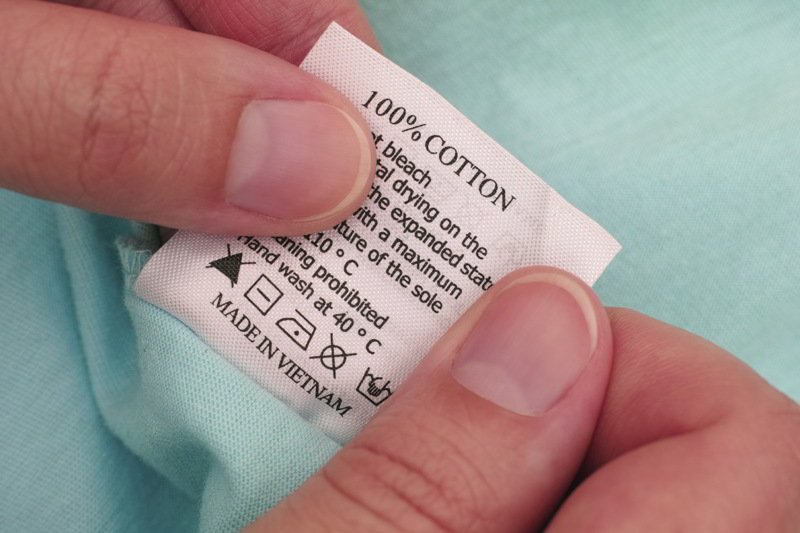
4. Beyond The US: A Note On International Care Labels (GINETEX)
While this guide focuses on US (ASTM/FTC) requirements, businesses involved in export markets, particularly Europe, should be aware of the GINETEX (International Care Labelling System).
GINETEX governs the symbol system widely used outside North America. While many symbols appear similar to ASTM symbols, a key difference exists: GINETEX symbols are registered trademarks. Using them in member countries often requires licensing agreements and potentially fees paid to the national GINETEX body.
Furthermore, labeling requirements in other countries can differ regarding mandatory information (like fabric composition/fiber content percentages), language requirements, and symbol usage. Always verify the specific regulations for your target export markets to ensure full compliance.
5. Practical Tips For Small Apparel Businesses
Navigating care labels involves practical choices beyond just understanding symbols and rules:
Choosing Label Material:
- Woven Labels: Often made using a Damask weave, these offer a premium feel, excellent durability, and are soft against the skin. They are great for branding but might have higher Minimum Order Quantities (MOQs).
- Printed Labels: Typically printed on Satin Polyester (soft, good for detailed logos/text) or Tyvek (very durable, waterproof, often more cost-effective, but can feel stiffer). Printed labels often allow lower MOQs.
- Consider the garment type (e.g., softer satin for intimates, durable Tyvek for outerwear), budget, desired aesthetic, and feel. Recycled material options are increasingly available for both woven and printed labels.
Determining Instructions:
- Never guess. Rely on detailed specifications from your fabric supplier, including fiber content and recommended care.
- Test prototypes using the intended care instructions to confirm they work without causing damage. Remember to consider all components – main fabric, linings, trims, threads, buttons, zippers. The care instruction must be safe for the most delicate part.
- Document your testing or the information you relied upon – this forms your “reasonable basis” required by the FTC.
Sourcing Labels:
- Numerous suppliers exist, both online printers specializing in apparel labels and potentially local providers.
- Compare pricing, MOQs, turnaround times, material options, and quality.
- Decide between using standard care symbols or creating custom labels that incorporate your logo alongside the care information for enhanced branding. Ensure any custom design still meets legibility and permanence requirements.
6. Common Care Labeling Mistakes To Avoid
Even with good intentions, mistakes happen. Be vigilant to avoid these common pitfalls:
- Vague Instructions: Using terms like “Wash Gently” without specifying temperature or cycle, or “Dryclean” without indicating solvent restrictions if necessary.
- Missing Warnings: Failing to warn against bleach, hot ironing, or other common procedures that could damage the specific garment, especially if not explicitly forbidden by the main instruction.
- Non-Permanent Labels: Using labels that fall off after a few washes or are easily removed. Ensure the attachment method is secure for the garment’s lifespan.
- Illegible Print/Material: Choosing materials that fray easily, or print methods where the ink fades or bleeds quickly, rendering the permanent label useless.
- Using Incorrect Symbols: Mixing up symbols (e.g., gentle wash vs. permanent press) or using symbols not recognized or appropriate for the US market (if selling domestically).
- Lack of Reasonable Basis: Assigning care instructions based on assumptions rather than testing, supplier data, or reliable evidence. This violates FTC rules and risks garment damage and customer dissatisfaction.
7. Related Questions
7.1 Can care labels in the US use only symbols without words?
Yes, according to the FTC rule referencing ASTM D5489, symbols alone can be used if they are commonly understood or if their meaning is explained (e.g., on a hang tag or packaging, especially when symbols are first introduced or less common). However, clarity is key, and many brands choose to use both symbols and text for maximum understanding.
7.2 Does the FTC specify the exact placement for care labels?
No, the FTC does not mandate a specific placement (like center back neck or left side seam). The rule only requires that the label be easily found by the consumer *before* purchase. Common industry practice places them in seams (side, neck) or waistbands for accessibility without detracting significantly from the garment’s appearance.
7.3 How do I determine care instructions if a garment uses multiple fabric types?
The care instructions must be suitable for the entire garment. Generally, this means providing instructions based on the requirements of the most delicate fabric type or component (including trims, linings, etc.). For instance, if a cotton shirt has delicate lace trim requiring hand washing, the entire garment’s label should indicate hand washing, even if the cotton itself could handle machine washing. Alternatively, ensure the chosen method is safe for all components.
7.4 Do accessories like scarves or belts need care labels?
It depends. The FTC rule applies to Textile Wearing Apparel, defined as finished garments customarily used to cover or protect the body. Scarves made primarily of textiles generally fall under this and require care labels if they need regular care.
Belts are more variable; a simple leather belt might not, but a fabric belt or one with significant textile components needing specific cleaning likely would. Check the specific materials and construction against FTC definitions if unsure.
Read more:
Accurate Care Labels are not merely a regulatory formality; they are an essential component of producing a quality product and building a trustworthy brand. Adhering to FTC compliance protects your business legally, while clear garment care instructions preserve the quality and longevity of your apparel.
Most importantly, thoughtful labeling demonstrates respect for your customers and their investment, fostering customer trust and enhancing your brand’s reputation. View care labeling not as a cost or burden, but as an integral part of your commitment to quality and customer satisfaction – turning a requirement into a valuable brand asset.






















